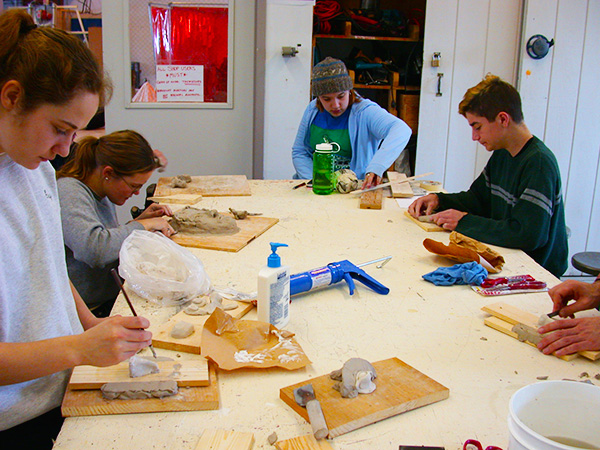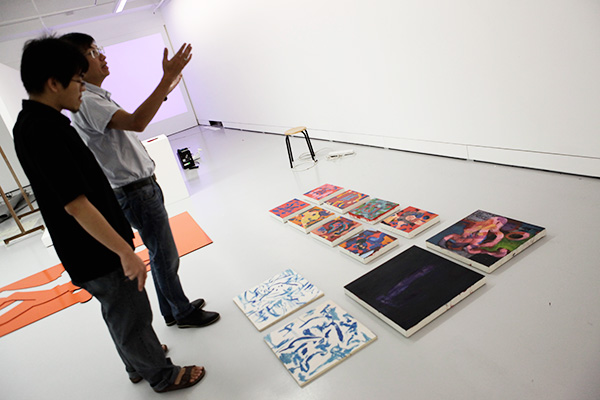

Shinji Ohmaki (Artist)
Participation in the exhibition “Viewpoint from Galleries: Focusing on a New Generation in Tokyo 2002” (held at contemporary art galleries in Ginza, including Gallery K, Gallery Yamaguchi, Galerie Tokyo Humanité, Gallery GEN and Gallery Kobayashi) provided me the opportunity to consider an artist-in-residence (AIR) program. An artist who was a guest speaker at a symposium accompanying the exhibition saw my exhibit and introduced me to the residency program at Vermont Studio Center in northeastern United States, the largest institution of its kind in the country.
Inevitable setbacks
Having received brochures and other materials, I started preparing my application. But I remember being at a loss for what to write in my “statement” (descriptions and explanations of one’s own work), which was a struggle to complete. Applicants were asked to submit two reference letters, a résumé, the statement, and 20 slides (replaced nowadays by digital images or Power Point data, I suppose). All this had to be translated into English and signed by referees, which was more time-consuming than expected. I did not have anyone close at hand with AIR experience to consult, which compounded my anxiety. The application I finally managed to send off arrived several days after the deadline due to airmail service delays and postal circumstances in the recipient country. Although my application for a fellowship was thus invalid, the Center proposed an alternative slot that came with housing, studio space and meals. This was very tempting. However, I thought that I would be putting myself at huge risk if I quit my job to participate without a guarantee of employment upon my return. As my preference was for residency with a scholarship award, I resisted the temptation, made up my mind to decline the offer, and emailed the Center that I would re-apply next time. I was able to prepare my second application, submitted the following year, much more smoothly.
Glitches are an inevitable part of any new challenge. I think it is crucial not to give up in the face of such setbacks. Heriberto Quesnel, a Mexican artist I met in Vermont, told me he had applied for many residency programs simultaneously. Overseas artists are very self-motivated. At the Center I came across participants exchanging residency information, some even preparing their next residency applications. Such artists seemed to deliberately choose to develop their artistic careers by going from one residency to another.
Interaction with the local community and encounters with artists
In the past I have participated in AIR programs in the US, South Korea and Singapore. Each residency was unique. At the Vermont Studio Center in the US, for instance, participants engaged in their own subjects while interacting with fellow participants and the local community. Roughly 160 visual artists, poets and writers from a wide range of age groups lived together at the residence. The residence is operated with support in the form of corporate sponsorship and donations from artists. The presence of scholarship program participants also seemed to make a year-round contribution to the economy of the small host town. The town of Johnson, Vermont, where the Center is located, works in partnership with educational institutions to generate employment. There was also a system for young artists to work as Center staff while also engaging in artistic creation. This system enables the Center to support young artists not only by providing studio space but also employment opportunities. The general goal of this residency program, which includes collaboration with educational institutions and promotion of cultural exchange with Asia and Europe, makes it suitable for participation by both young and seasoned artists.

Sculpture workshop held at Johnson State College during my residency at Vermont Studio Center
One of my other residencies was at SSamzie Space in Korea, where I stayed in October 2006. Young Korean artists live and work there throughout the year. Overseas artists can also apply for residency places, either voluntarily or on the recommendation of others. About 12 foreign artists are selected each year to engage in studio work or research for one cours (three months). Activities are apparently similar to the Vermont Studio Center, but this residency program is distinct in that it creates opportunities for participants to launch their careers as full-fledged artists through contact with world-class art directors and curators who frequently visit the Space. I participated on the recommendation of Tokyo Wonder Site. At the time I was interested in learning about cultures and art in other parts of Asia. I also had an upcoming project at Hyundai Department Store, so my application for SSamzie Space could not have been better timed.
There were numerous encounters over there. Of particular personal significance was meeting Korean art curator Kim Sunjung and internationally-renowned artist Lee Bul. Through the introduction of Ms. Kim, I had the privilege of visiting Ms. Lee at her home, where the artist showed me her studio and discussed various topics with me, which was a very memorable experience. I was also impressed by the fact that Ms. Lee actively supports young Korean artists by collecting their works. While living in Korea I made a conscious effort to learn the Korean language as best as I could, so as to better appreciate Korean culture. The people I met during my residency led to my subsequent art commissions in Korea.

Exhibition by Australian artist Ian Haig at the final open studio exhibition at SSamzie Space
How to prepare for a residency and get the most out of it
During a residency, an artist is constantly demanded to communicate to others “who he/she is,” in the course of open studios or lectures about his/her work. Moreover, this must be done in English, which is not an easy task. With only moderate confidence in my English, I racked my brains as I navigated through each occasion, eventually arriving at ways of communicating with fellow artists. At Vermont, for example, we had a get-together called “tea time” every day at 15:00. More residents showed up as days went by, growing from the initial three to five and then ten. As I showed my portfolio and talked, as best as I could in English, others started to interpret my works and explain them in their own ways. It was exhilarating to witness a dialog develop through my own creations.
Sometimes there are situations unique to a particular host country that you should know about beforehand. At the very least, I recommend the following preparation to make a residency worthwhile:
● Thoroughly research what the AIR program offers
● Summarize what you do and/or what you want to do so that others can comprehend
● Find and consult someone who has already been there
Nowadays, organizations such as The Japan Foundation and Tokyo Wonder Site have a wealth of information, so it might also be useful to consult them or attend lectures and other events they host. Just for the sake of mentioning it, the office of SSamzie Space in Korea had a directory listing information about residencies around the world. Until I looked at this directory I never realized that there were so many residencies in the world offering such a variety of opportunities. It is crucial to maintain an inquisitive mind and the enthusiasm to put things into action. The first step toward gaining anything is to actually go abroad and participate physically. Being at the very location sets the ball rolling, as opposed to merely toying with the idea.
In my case, I was recommended for a residency just as I was feeling the need to change something about my career as an artist. As described above, I experienced slight difficulties, but today it is relatively easy to obtain information about residency programs from the internet and other sources, so I recommend artists to experience different countries as early as possible in their careers.
Air pocket-like experience
I believe the most important thing about participation in an AIR program is meeting other people. The thought process that accompanies the various experiences brought about by encounters with artists from around the world as well as local people, provides an ideal opportunity for learning about diverse values.
I used to think that art was a one-way process of presenting something, mainly by creating a physical object. However, my ideas changed dramatically in the course of interacting with other artists, curators and local people in different countries. I now believe that art is an act of exchanging something for something else through the process of interaction with other people. I strongly recommend aspiring young artists to make active use of AIR programs to experience the outside world. Art is an ever-evolving process powered by mutual exchange. When you exchange emails or conversations with the people you meet, you are in a sense exchanging “the present” with them. Going abroad on your own accord, where you eat and spend time with the people you meet there, will naturally connect you to a wider world and expand your horizons, as you accumulate such experiences. This may seem obvious, which is exactly why I want young people to put their reservations aside and have a go at what they desire. A residency is an air pocket-like experience, in which you are momentarily transferred to a place cut off from everyday routines, where you take a break, reflect on yourself to date, and think about the future. Your values will probably expand enormously, compared to when you only experienced everyday life in Japan. I hope that many artists, curators and researchers will take part in AIR programs and in doing so become active players in a future where Japan has a global presence and strong global ties.

Installing an exhibition during Tropical Lab, a residency program hosted by Lasalle College of the Arts, Singapore. The program’s technical staff offer support to participating artists.
Shinji Ohmaki
Born in 1971. Artist. Lecturer, Department of Sculpture, Faculty of Fine Arts, Tokyo University of the Arts. Works include “Echo” series (Shiseido Gallery, Tokyo Gallery + Beijing Tokyo Art Projects, Taro Okamoto Museum of Art, Art Tower Mito, etc.); Liminal Air (Tokyo Wonder Site, Gallery A4, 21st Century Museum of Contemporary Art, Kanazawa, etc.); Memorial Rebirth (Yokohama Triennale 2008)
URL=http://www.shinjiohmaki.net/
[March 31, 2011]
2024.7.9Acasă la Hundorf Residency JournalArtist : Miyake Suzuko
2023.5.14AIR and I, 09 : Mentoring Artists for Women’s Art (MAWA) Residence Report